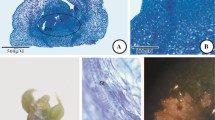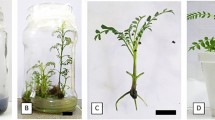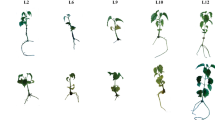Abstract
Turmeric (Curcuma longa L. (Zingiberaceae)) is a rich source of medicinally important chemical compounds obtained from both pseudostem (aboveground part) and rhizome (underground part). However, the availability of disease-free elite varieties of the plant is highly restricted. Leaf spot caused by Colletotrichum curcumae Butler & Bisby and bacterial wilt caused by Ralstonia pseudosolanacearum Safni have been reported as major diseases responsible for reduced rhizome productivity in the turmeric plant. Meristem culture is a well-known alternative for production of disease-free mother rhizome. The aim of this investigation was to eradicate bacterial and fungal disease instances through culturing of meristematic tissue pretreated with 1.44 to −2.88 μM GA (gibberellic acid) followed by detection of disease contamination using PCR amplification and chemical assay. Meristem (0.5 to 2.0 mm) was identified as a good material for initiating tissue culture, as it exhibited 100% survival rate and absence of R. pseudosolanacearum and C. curcumae when tested with SPA (sucrose peptone agar), TZC (Kelman’s tripheny tetrazolium chloride), and PDA (potato dextrose agar) selective media. Plantlets derived from meristematic tissues of size 2.0 mm were healthy and displayed rapid recovery and uniformity in size. Disease-free status of plantlets (derived from meristem culture) was confirmed by PCR products of specific primers, RP1F/RP1R and RP3F/RP3R for R. pseudosolanacearum and CCactF/CCactR and CChisF/CChisR for C. curcumae. Moreover, shoot elongation using supplemented GA in the culture medium was successfully induced for meristem cutting. All meristem cultures pretreated with GA were confirmed to be contamination-free through TZC, SPA, and PDA media as well as PCR amplification. Based on this study, the 1.0 to 2.0 mm in size of meristem cutting and pretreatment with 1.44 to 2.88 μM GA for shoot elongation were successfully identified in addition to confirming the disease-free status of the plantlets using chemical assay and PCR products.




Similar content being viewed by others
References
Adhipathi P, Nakkeeran S, Chandrasekaran A (2013) Morphological characterization and molecular phylogeny of Colletotrichum capsici causing leaf spot disease of turmeric. Bioscan 8:331–337
Ajitomi A, Inoue Y, Horita M, Nakaho K (2015) Bacterial wilt of three Curcuma species, C. longa (turmeric), C. aromatica (wild turmeric), C. zedoaria (zedoary) caused by Ralstonia solanacearum in Japan. J Gen Plant Pathol 81:315–319. https://doi.org/10.1007/s10327-015-0596-9
Bawa G, Feng L, Chen G, Chen H, Hu Y, Pu T, Cheng Y, Shi J, Xiao T, Zhou W, Yong T, Sun X, Yang F, Yang W, Wang X (2020) Gibberellins and auxin regulate soybean hypocotyl elongation under low light and high-temperature interaction. Physiol Plant 170:345–356. https://doi.org/10.1111/ppl.13158
Cannon PF, Damm U, Johnston PR, Weir BS (2012) Colletotrichum – current status and future directions. Stud Mycol 73:181–213. https://doi.org/10.3114/sim0014
Cellier G, Moreau A, Chabirand A, Hostachy B, Ailloud F, Prior P (2015) A duplex PCR assay for the detection of Ralstonia solanacearum phylotype II strains in Musa spp. PLoS One 10:e0122182. https://doi.org/10.1371/journal.pone.0122182
Cha-um S, Hien NT-T, Kirdmanee C (2006) Disease-free production of sugarcane varieties (Saccharum officinarum L.) using in vitro meristem culture. Biotechnology 5:443–448
Cha-um S, Kirdmanee C, Huyen PX, Vathany T (2007) Disease-free production and minimal-growth preservation of in vitro banana (Musa spp.). Acta Hortic 760:233–240. https://doi.org/10.17660/ActaHortic.2007.760.30
Dashti AA, Jadoan MM, Abdulsamad AM, Dashti HM (2009) Heat treatment of bacteria: a simple method of DNA extraction for molecular techniques. Kuwait Med J 41:117–122
Doyle JJ, Doyle JL (1990) Isolation of plant DNA from fresh tissue. Focus 12:13–15
El-Dougdoug KA, El-Shamy MM (2011) Management of viral disease in banana using certified and virus tested plant material. Afr J Microbiol Res 5:5923–5932. https://doi.org/10.5897/AJMR11.966
Fukuda M, Matsuo S, Kikuchi K, Mitsuhashi W, Toyomasu T, Honda I (2012) Gibberellin metabolism during stem elongation stimulated by high temperature in lettuce. Acta Hortic 932:259–264. https://doi.org/10.17660/ActaHortic.2012.932.52
Gupta R, Chakrabarty SK (2013) Gibberellic acid in plant: still a mystery unresolved. Plant Signal Behav 8:e25504. https://doi.org/10.4161/psb.25504
Gupta SC, Kismali G, Aggarwal BB (2013) Curcumin, a component of turmeric: from farm to pharmacy. Biofactors 39:2–13. https://doi.org/10.1002/biof.1079
Hamill SD, Rames E (2016) An effective indexing method for banana tissue culture provides long-term freedom from bacterial contamination. Acta Hortic 1205:741–748. https://doi.org/10.17660/ActaHortic.2018.1205.92
Helliot B, Panis B, Poumay Y, Swennen R, Lepoivre P, Frison E (2002) Cryopreservation for elimination of cucumber mosaic and banana streak viruses from banana (Musa spp.). Plant Cell Rep 20:1117–1122. https://doi.org/10.1007/s00299-002-0458-8
Horita M, Sakai YK (2020) Specific detection and quantification of Ralstonia pseusolanacearum race 4 strains from Zingiberaceae plant cultivation soil MPN-PCR. J Gen Plant Pathol 86:393–400. https://doi.org/10.1007/s10327-020-00939-x
Hudge BV, Ghogul SV (2010) Losses in yield and quality of turmeric due to leaf spot disease caused by Colletotrichum capsici. Int J Agric Sci 6:43–45
Inoue Y, Nakaho K (2014) Sensitive quantitative detection of Ralstonia solanacearum in soil by the most probable number-polymerase chain reaction (MPN-PCR) method. Appl Microbiol Biotechnol 98:4169–4177. https://doi.org/10.1007/s00253-014-5604-z
Kabyyashree K, Kumar R, Sen P, Satapathy SS, Ray SK (2020) Ralstonia solanacearum preferential colonization in the shoot apical meristem explains its pathogenicity pattern in tomato seedlings. Plant Pathol 69:1347–1356. https://doi.org/10.1111/ppa.13220
Kamle M, Pandey BK, Kumar P, Kumar MM (2013) A species-specific PCR based assay for rapid detection of mango anthracnose pathogen Colletotrichum gloeosporioides Penz. and Sacc. J Plant Pathol Microbiol 4:184. https://doi.org/10.4172/2157-7471.1000184
Karimi K, Arzanlou M, Pertot I (2020) Development of novel species-specific primers for the specific identification of Colletotrichum nymphaeae based on conventional PCR and LAMP techniques. Eur J Plant Pathol 156:463–475. https://doi.org/10.1007/s10658-019-01895-9
Kelman A (1954) The relationship of pathogenicity of Ralstonia solanacearum to colony appearance on a tetrazolium medium. Phytopathology 44:693–695
Koeda S, Takisawa R, Nabeshima T, Tanaka Y, Kitajima A (2015) Production of tomato yellow leaf curl virus-free parthenocarpic tomato plants by leaf primordia-free shoot apical meristem culture combined with in vitro grafting. Hortic J 84:327–333. https://doi.org/10.2503/hortj.MI-055
Kumar S, Khan MS, Raj SK, Sharma AK (2009) Elimination of mixed infection of Cucumber mosaic and Tomato aspermy virus from Chrysanthemum molifolium Ramat. cv. Pooja by shoot meristem culture. Sci Hortic 119:108–112. https://doi.org/10.1016/j.scienta.2008.07.017
Leifert C, Cassells AC (2001) Microbial hazards in plant tissue cultures. In Vitro Cell Dev Biol - Plant 37:133–138. https://doi.org/10.1079/IVP2000129
Little CHA, MacDonald JE (2003) Effects of exogenous gibberellin and auxin on shoot elongation and vegetative bud development in seedlings of Pinus sylvestris and Picea glauca. Tree Physiol 23:73–83. https://doi.org/10.1093/treephys/23.2.73
MacDonald JE (2017) Applying paclobutrazol at dormancy induction inhibits shoot apical meristem activity during terminal bud development in Picea mariana seedlings. Trees 31:229–235. https://doi.org/10.1007/s00468-016-1475-5
Mathew L, Tiffin H, Errid MLA, Hunter D, Pathirana R (2021) Efficiency of eradication of Raspberry bushy dwarf virus from infected raspberry (Rubus idaeus) by in vitro chemotherapy, thermotherapy and cryotherapy and their combinations. Plant Cell Tissue Organ Cult 144:133–141. https://doi.org/10.1007/s11240-020-01829-y
Milosevic S, Subotic A, Bulajic A, Djekic I, Jevremovic S, Vucurovic A, Krstic B (2011) Elimination of TSWV from Impatiens hawkerii Bull. and regeneration of virus-free plant. Electron J Biotechnol 14:3–4. https://doi.org/10.2225/vol14-issue1-fulltext-5
Murashige T, Skoog F (1962) A revised medium for rapid growth and bioassays with tobacco tissue cultures. Physiol Plant 15:473–497. https://doi.org/10.1111/j.1399-3054.1962.tb08052.x
Nasri H, Sahinfard N, Rafieian M, Rafieian S, Shirzad M, Rafieian-kopaei M (2014) Turmeric: a spice with multifunctional medicinal properties. J Herb Med Plarmacol 3:5–8
Naz S, Ilyas S, Javad S, Ali A (2009) In vitro clonal multiplication and acclimatization of different varieties of turmeric (Curcuma longa L.). Pak J Bot 41:2807–2816
Okiro LA, Tancos MA, Nyanjom SG, Smart CD, Parker ML (2019) Comparative evaluation of LAMP, qPCR, conventional PCR, and ELISA to detect Ralstonia solanacearum in Kenyan potato fields. Plant Dis 103:959–965. https://doi.org/10.1094/PDIS-03-18-0489-RE
Panis B, Piette B, Swennen R (2005) Droplet vitrification of apical meristems: a cryopreservation protocol applicable to all Musaceae. Plant Sci 168:45–55. https://doi.org/10.1016/j.plantsci.2004.07.022
Prameela TP, Bhai RS (2020) Bacterial wilt of ginger (Zingiber officinale Rosc.) incited by Ralstonia pseudosolanacearum- a review based on pathogen diversity, diagnostics and management. J Plant Pathol 102:709–719. https://doi.org/10.1007/s42161-020-00487-5
Prasad S, Tyagi AK, Aggarwal BB (2014) Recent developments in delivery, bioavalability, absorption and metabolism of curcumin: the golden pigment from golden spice. Cancer Res Treat 46:2–18. https://doi.org/10.4143/crt.2014.46.1.2
Prihastuti H, Sato T, Shivas RG, Tan YP, Taylor PWJ, Weir BS, Yang YL, Zhang JZ (2009) Colletotrichum-names in current use. Fungal Divers 39:147–182
Quiroz KA, Berrios M, Carrasco B, Retamales JB, Caligari PDS, Garcia-Gonzales R (2017) Meristem culture and subsequent micropropagation of Chilean strawberry (Fragaria chiloensis (L.) Duch.). Biol Res 50:20. https://doi.org/10.1186/s40659-017-0125-8
Ramgareeb S, Snyman SJ, Antwerpen TV, Rutherford RS (2010) Elimination of virus and rapid propagation of disease-free sugarcane (Saccharum spp. cultivar NCo376) using apical meristem culture. Plant Cell Tissue Organ Cult 100:175–181. https://doi.org/10.1007/s11240-009-9634-7
Rao TN (1995) Diseases of turmeric (Curcuma longa L.) and their management. J Spice Aroma Crop 4:49–56
Sahoo PP, Sarangi KK (2018) Value chain analysis of organic turmeric in Kandhamal district of Odisha. J Pharmacog Phytochem 7:1130–1137
Sanabam R, Singh NS, Handique PJ, Devi HS (2015) Disease-free khasi mandarin (Citrus reticulata Blanco) production using in vitro microshoot tip grafting and its assessment using DAS-ELISA and RT-PCR. Sci Hortic 189:208–213. https://doi.org/10.1016/j.scienta.2015.03.001
Sharifi-Rad J, Rayess YE, Rizk AA, Sadaka C, Zgheib R, Zam W, Sestito S, Rapposelli S, Neffe-Skocińska K, Zielińska D, Salehi B, Setzer WN, Dosoky NS, Taheri y, El-Beyrouthy M, Martorell M, Ostrander EA, HAR S, Cho WC, Maroyi A, Martins N (2020) Turmeric and its major compound curcumin on health: bioactive effects and safety profiles for food, pharmaceutical, biotechnological and medicinal applications. Front Phamacol 11:01021. https://doi.org/10.3389/fphar.2020.01021
Singh J, Cobb-Smith D, Higgins E, Khan A (2020) Comparative evaluation of lateral flow immunoassays, LAMP, and quantitative PCR for diagnosis of fire blight in apple orchards. J Plant Pathol. https://doi.org/10.1007/s42161-020-00644-w
Stulberg MJ, Shao J, Huang Q (2015) A multiplex PCR assay to detect and differentiate select agent strains of Ralstonia solanacearum. Plant Dis 99:333–341. https://doi.org/10.1094/PDIS-05-14-0483-RE
Su WR, Chen WS, Koshioka M, Mander LN, Hung LS, Chen WH, Fu YM, Huang KL (2001) Changes in gibberellin levels in the flowering shoot of Phalaenopsis hybrida under high temperature conditions when flower development is blocked. Plant Physiol Biochem 39:45–50. https://doi.org/10.1016/S0981-9428(00)01218-3
Tanimoto E (2012) Tall or short? Slender or thick? A plant strategy for regulating elongation growth of roots by low concentrations of gibberellin. Ann Bot 110:373–381. https://doi.org/10.1093/aob/mcs049
Tiwari AK, Tripathi S, Lal M, Sharma ML, Chiemsombat P (2011) Elimination of sugarcane grassy shoot disease through apical meristem culture. Arch Phytopathol Pflanzenschutz 44:1942–1948. https://doi.org/10.1080/03235408.2010.544446
Verma N, Ram R, Hallan V, Kumar K, Zaidi AA (2004) Production of Cucumber mosaic virus-free chrysanthemums by meristem tip culture. Crop Prot 23:469–473. https://doi.org/10.1016/j.cropro.2003.08.021
Vivek M, Modgil M (2018) Elimination of viruses through thermotherapy and meristem culture in apple cultivar ‘Oregon Spur-II’. Virus Dis 29:75–82. https://doi.org/10.1007/s13337-018-0437-5
Wondimu T, Feyissa T, Bedada G (2012) Meristem culture of selected sweet potato (Ipomea batatas L. Lam.) cultivars to produce virus-free planting material. J Hortic Sci Biotechnol 87:255–260. https://doi.org/10.1080/14620316.2012.11512861
Yadeta K, Thomma B (2013) The xylem as battleground for plant hosts and vascular wilt pathogens. Front Plant Sci 4:97. https://doi.org/10.3389/fpls.2013.00097
Yao J, Lan C, Huang P, Yu D (2018) PCR detection of Colletotrichum gloeosporioides in Psidium guajava. Aust Plant Pathol 47:95–100. https://doi.org/10.1007/s13313-018-0540-5
Funding
This work was financially supported by the National Science and Technology Development Agency (NSTDA Grant Number P-18-52840).
Author information
Authors and Affiliations
Contributions
CT and MMMK conducted the experiments and collected data and wrote the manuscript draft. TS, UP, and NW collected the data, designed the primer, and undertook data analysis. SC designed the experiments and assisted in data analysis and manuscript writing and editing.
Corresponding author
Additional information
Editor: Gregory Phillips
Supplementary Information
Supplementary Tables 1
(DOCX 14 kb)
Supplementary Figures 1
(PPTX 409 kb)
Rights and permissions
About this article
Cite this article
Theerawitaya, C., Kyaw, M.M.M., Samphumphuang, T. et al. Shoot meristem culture eliminates bacterial and fungal infections from elite varieties of turmeric (Curcuma longa L.). In Vitro Cell.Dev.Biol.-Plant 58, 146–154 (2022). https://doi.org/10.1007/s11627-021-10207-y
Received:
Accepted:
Published:
Issue Date:
DOI: https://doi.org/10.1007/s11627-021-10207-y




